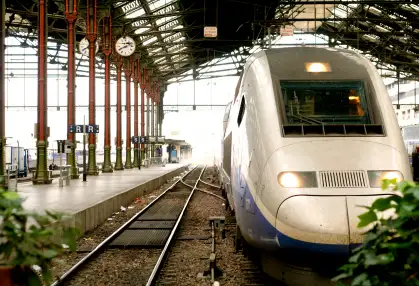
“If you can’t beat ’em, join ’em”: SNCF, the French railway system, has decided to fight low-fare airlines with low-fare trains. Starting April 2, new budget-priced Ouigo high-speed trains will make three round trips a day—four on Saturdays—on the high-speed trunk line between Paris and the Mediterranean coast, splitting near Avignon, with one section to Marseille and the other to Montpellier. Both the pricing and the operation will parallel the ways low-fare airlines operate.
- Trains use some peripheral rather than downtown stops: The Paris terminal is at Marne-la-Vallee Chessy (Disneyland Paris) rather than Gare du Lyon, and at Lyon, most trains stop at St Exupury Airport rather than downtown Part Dieu.
- Trains are 100 percent second class, with seating comparable to second class on regular TGVs. For some reason, a few cars have 1-3 seating rather than the usual 2-2. But at least no seats are at a cattle-car 3-2 that an airline would use in a similar-sized cabin.
- Trains have no food or bar areas; instead that space will be used for more seats or more baggage space.
- Ticket prices are competitive with prices on EasyJet and Ryanair: capacity-controlled, with some seats priced at 10 euros (about $13); at least 25 percent of the seats priced below 25 euros, and a maximum of 85 euros. Children accompanied by an adult pay a flat fee of 5 euros for any trip.
- Base ticket prices include only one piece of baggage plus a handbag/briefcase. Each extra bag costs 5 to 10 euros.
- Ouigo tickets are available only online, through a special Ouigo website. So far, RailEurope hasn’t responded to my inquiry about selling Ouigo tickets in the United States, but if it doesn’t, presumably you can use the Ouigo site.
Speeds are the same as regular TGV speeds on the main line—generally maxing at around 190 miles per hour. As with all TGV services, running time is competitive with flying, given the necessities of airport access, checking in, and the other hassles of air travel. And overall, Ouigo travel should be much more comfortable than flying an EasyJet or Ryanair cattle car.
Ouigo sells tickets through an all-new dedicated online operation, and it’s not yet fully implemented. Even the base French website is still a work in progress. And the counterpart English website still returns to the French page, and links from the English page to all the secondary pages respond, “Desole, la page que vous demandez n’existe pas” (“We’re sorry; the page you requested does not exist” to you Anglophones). Presumably, SNCF will fix all that soon.
Travelers to/from central Paris or Lyon have direct rail-transit access to/from the peripheral stations. To me, the main surprise is that the Paris terminal is at Marne-la-Vallee rather than Charles DeGaulle, a few miles to the north. That station has the better transit access to central Paris, but maybe SNCF wants to confine lucrative airport traffic to its higher-priced options. And for air travelers, the only rail service between Marne-la-Vallee and DeGaulle is by relatively infrequent TGV trains; there’s no conventional transit except through central Paris.
Clearly, SNCF wants to retain its dominance of Paris-Lyon-Marseille-Montpellier traffic against any incursions from low-fare airlines. And low-fare airlines are trying: EasyJet flies to the South of France from Orly, Ryanair from remote Beauvais (which it laughingly calls “Paris/Beauvais”), and Air France is about to launch its own low-fare operation, Hop, to serve domestic markets.
Under the financial pressures of austerity budgets, SNCF is looking to concentrate on its most profitable routes and drop those that don’t make enough money. Ouigo is clearly an attempt to gain additional margin on the most important rail line in France. Presumably, if it is successful, you can expect an expansion. But any expansion will be tempered by a need to retain the higher prices on conventional TGV services.
As you probably figured, “Ouigo” is pronounced as “we go” in English. Just another French bow to the emerging international “Globish” standard.
Ed Perkins Seniors on the Go is copyright (c) 2012 Tribune Media Services, Inc.
You Might Also Like:
We hand-pick everything we recommend and select items through testing and reviews. Some products are sent to us free of charge with no incentive to offer a favorable review. We offer our unbiased opinions and do not accept compensation to review products. All items are in stock and prices are accurate at the time of publication. If you buy something through our links, we may earn a commission.
Related
Top Fares From
Today's Top Travel Deals
Brought to you by ShermansTravel
France: 8-Night Paris, Avignon & Nice...
Infinity Worldwide Vacations
 vacation
$2880+
vacation
$2880+
Poconos: 3 Nts in Garden of...
ResortsAndLodges.com
 hotel
$305+
hotel
$305+
7-Nt Canada & New England Cruise,...
Princess Cruises
 cruise
$839+
cruise
$839+



